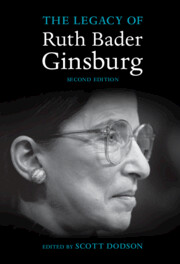Book contents
- The Legacy of Ruth Bader Ginsburg
- The Legacy of Ruth Bader Ginsburg
- Copyright page
- Contents
- Contributors
- Preface
- Foreword
- Acknowledgments
- Introduction to the Second Edition
- Part I Shaping a Legacy
- Part II Rights and Remedies
- Part III Structuralism
- Part IV The Jurist
- 13 Reflections on the Confirmation Journey of Ruth Bader Ginsburg, Summer 1993
- 14 Justice Ginsburg
- 15 Oral Argument as a Bridge between the Briefs and the Court’s Opinion
- 16 Fire and Ice
- Coda
- Notes
- Index
15 - Oral Argument as a Bridge between the Briefs and the Court’s Opinion
from Part IV - The Jurist
Published online by Cambridge University Press: 03 March 2022
- The Legacy of Ruth Bader Ginsburg
- The Legacy of Ruth Bader Ginsburg
- Copyright page
- Contents
- Contributors
- Preface
- Foreword
- Acknowledgments
- Introduction to the Second Edition
- Part I Shaping a Legacy
- Part II Rights and Remedies
- Part III Structuralism
- Part IV The Jurist
- 13 Reflections on the Confirmation Journey of Ruth Bader Ginsburg, Summer 1993
- 14 Justice Ginsburg
- 15 Oral Argument as a Bridge between the Briefs and the Court’s Opinion
- 16 Fire and Ice
- Coda
- Notes
- Index
Summary
A Supreme Court oral argument is an odd beast. Unlike at many other courts, in which oral argument represents the one time in which overworked judges can really focus on the issue, facts, and arguments of the parties, oral argument at the Supreme Court is not particularly important to the case’s outcome. The reasons are many. The Supreme Court’s docket is small – around eighty cases heard a year – allowing the justices the luxury of being able to focus deeply on each case. Each justice has four clerks, often among the brightest legal minds of their ages, to assist. The Court tends to restrict the issues presented to those that, in the main, involve broad legal principles rather than intricate factual disputes that tend to get cumbersome in briefs.
- Type
- Chapter
- Information
- The Legacy of Ruth Bader Ginsburg , pp. 199 - 203Publisher: Cambridge University PressPrint publication year: 2022

